Military operations overseas have always required the support of civilian ships, either government-owned or chartered. These were rarely sent directly into combat, instead being used to move cargo and troops from one port to another. In the US, these ships were managed by a number of different organizations, who often competed for tonnage. In the aftermath of WWII, it was decided to bring this cumbersome arrangement to an end, centralizing all military water transport under a single organization managed by the Navy, which became known as the Military Sea Transportation Service. The Army's transports were handed over to the Navy, which initially operated a mix of chartered, government-owned but civilian-manned and Navy-manned ships. The chartered vessels received a four-digit hull number and kept their existing merchant prefixes, while the civilian-manned ships were designed USNS, for United States Naval Ship. This was distinct from the USS used by commissioned and Navy-manned ships, which could legally be armed. Both types had their hull numbers prefixed by T- to indicate MSTS/MSC control, although MSTS ended the use of Naval crews in the 1960s.
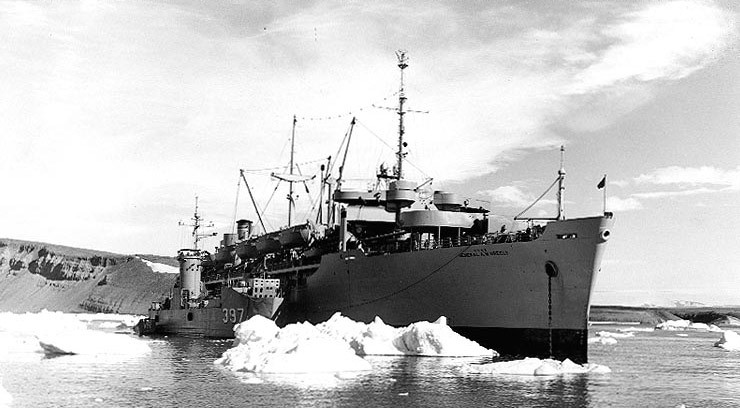
USNS General A.W. Greely at Thule, Greenland
MSTS, renamed Military Sealift Command (MSC) in 1970, provided cargo transport throughout the Cold War, supporting operations in Korea and Vietnam as well as less-visible military work around the world. It also began to take over operation of various special-mission ships for tasks like laying cables, hydrographic surveys, and tracking missile tests. But in 1971, investigation began on a new mission. The draft was coming to an end, and the cost of manpower was rising rapidly. So far, MSTS/MSC had only moved cargo point-to-point, but it could potentially take over many of the Navy's auxiliaries as well, much as the British Royal Fleet Auxiliary (RFA) had for the past several decades. After successful tests in 1972, the oiler Taluga was the first vessel decommissioned and turned over to MSC, with her crew of 314 being replaced by a 105-man civilian crew and a 16-man naval detachment primarily responsible for communications.1
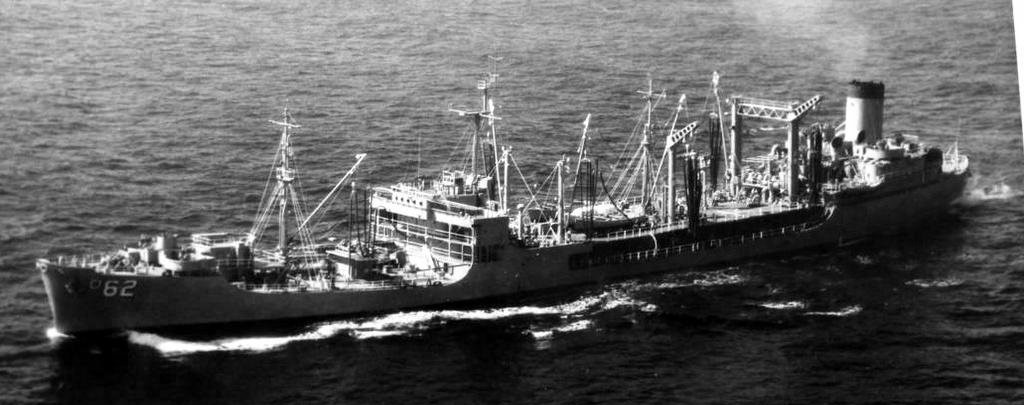
Taluga just before beginning her career with MSC
Taluga was very successful in MSC service, and the Navy began transferring more auxiliaries to civilian manning. Initially, these were the bulk oilers and stores ships, but during the 90s, even the fast Underway Replenishment (UNREP) ships were turned over to MSC. Today, nearly every auxiliary ship the USN owns is operated by MSC, the last transfers being the Safeguard class salvage ships in 2007.2 These ships are divided into three broad categories: the Combat Logistics Force, which operates underway replenishment vessels; Combatant Command Support, which carries out the original mission of point-to-point transport in support of DOD activities; and Fleet Support and Special Missions, which covers a broad range of vessels. Some are tasked with technical missions like surveying and ocean surveillance, while others do more mundane tasks like towing and salvage. In this category are also the prepositioning ships, kept near trouble spots with equipment for use by forces flown in from the US.
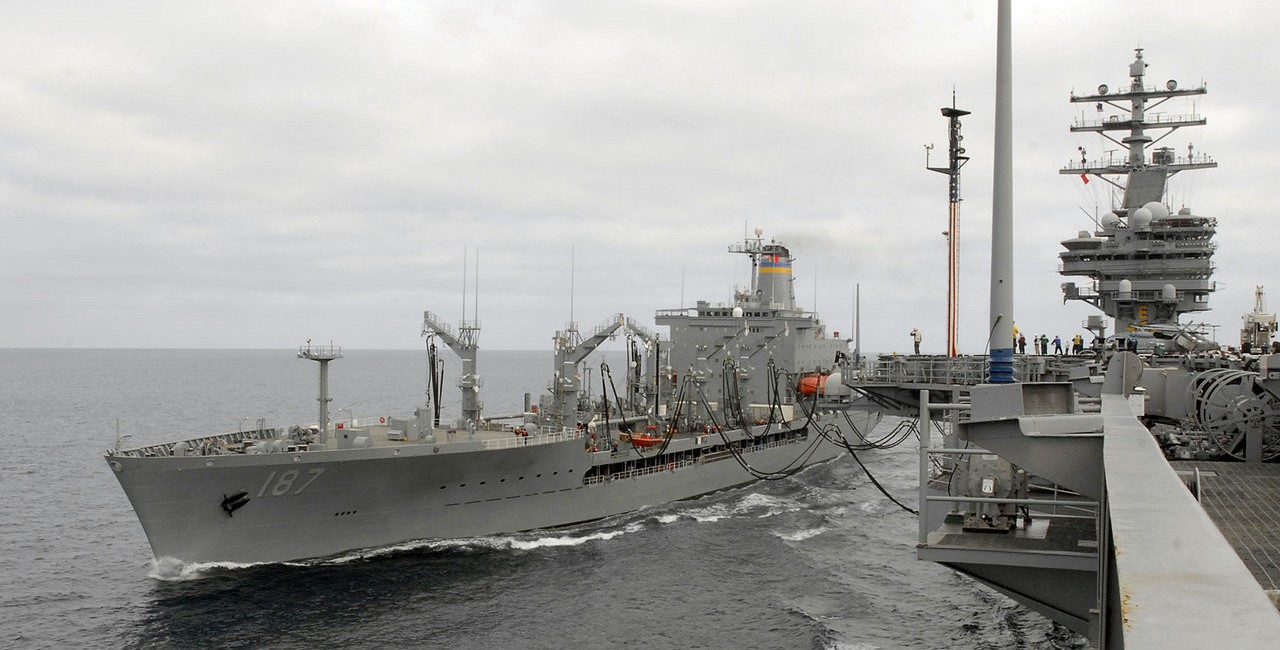
Oiler Henry J. Kaiser replenishes carrier Ronald Reagan
The Combat Logistics Force operates three kinds of ships, all tasked primarily with supporting the fleet at sea. The largest contingent is of 15 Henry J. Kaiser class oilers, each of which can carry approximately 180,000 barrels of petroleum products,3 a mix of fuel oil and jet fuel, while also carrying small quantities of dry and refrigerated cargo. These ships date back to the 80s, and are being replaced by the new John Lewis class, the lead ship of which was christened in July 2021.
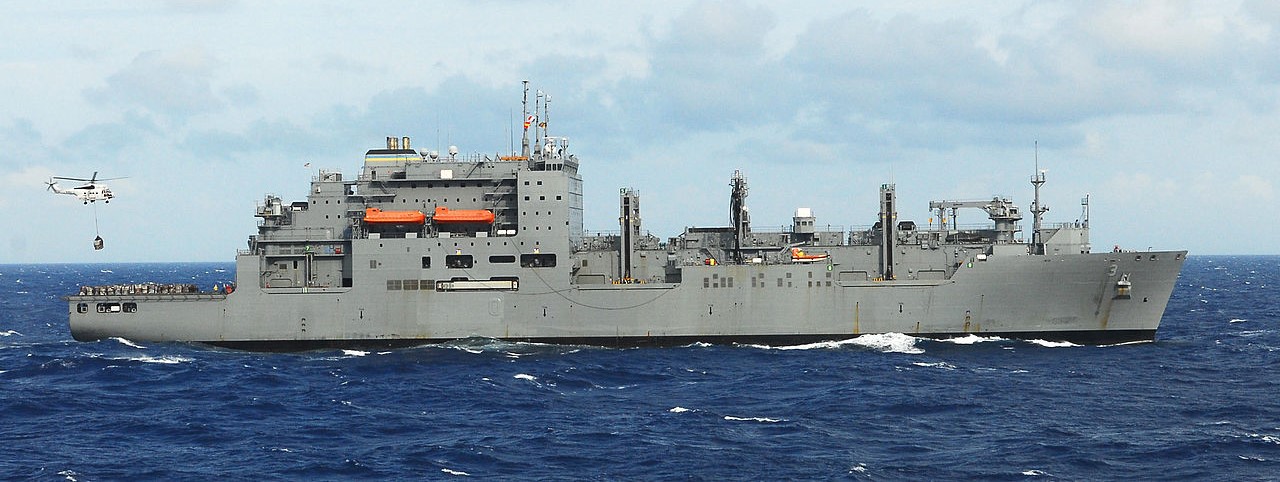
Dry cargo ship Alan Shepard
Only slightly smaller is the contingent of Lewis and Clark class dry cargo ships, which serve as a single-ship replacement for older ammunition and stores ships. They are capable of carrying not only 6,675 tons of dry cargo, which could be anything from bombs to spare parts to canned peaches, but also 1,716 tons of refrigerated or frozen food. This class pioneered a number of innovations for the USN, most notably all-electric engineering systems, with an integrated power grid that uses diesels to generate electricity that is used both for propulsion and to operate the ship's systems. To reduce manning requirements, the T-AKEs are also fitted with an Automated Storage and Retrieval System that can handle standard pallets and small containers at the push of a button, greatly easing the task of preparing for an UNREP. These ships can also offload small amounts of fuel oil, but are no replacement for a proper oiler.
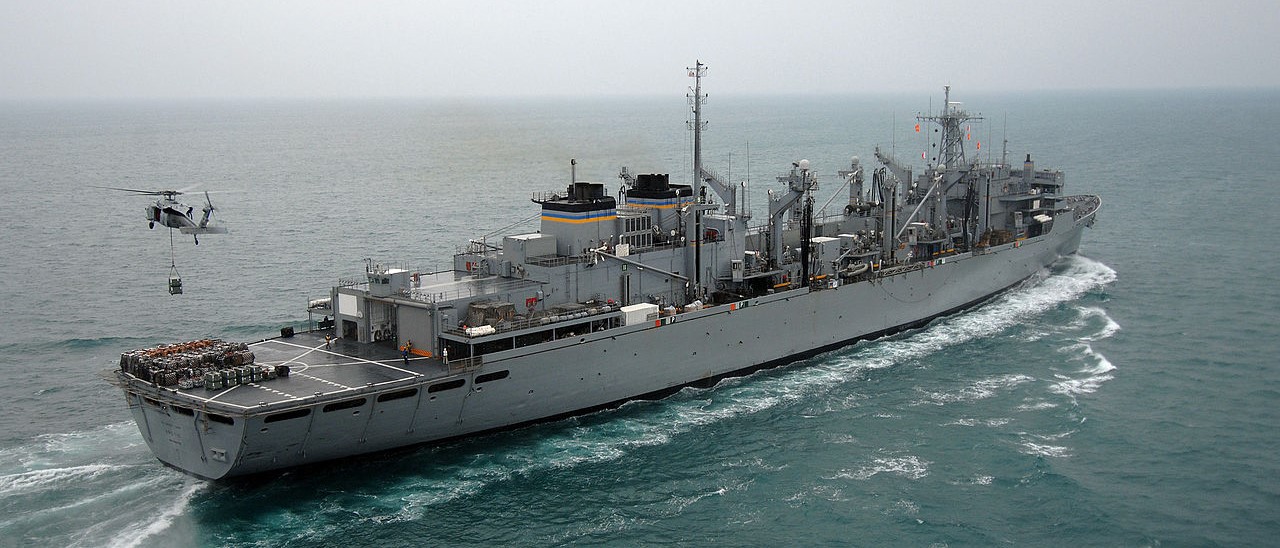
USNS Arctic, of the supply class, conducts vertical replenishment
Working together, an oiler and a T-AKE can provide essentially everything a battle group needs, but the ships are slow and generally built to civilian standards. Traditionally, the USN has operated a series of fast one-stop ships capable of supplying all of the group's needs and of keeping up with it, but such ships tend to be expensive to operate, and only two units of the Supply class remain in service. These vessels can carry 156,000 barrels of petroleum products, 1,800 tons of ammunition, 400 tons of refrigerated stores and 250 tons of other dry stores at 25 kts, a full 5 kts faster than the other vessels in the CLF. Two other ships of this type have already been retired, and no replacement is on the horizon.
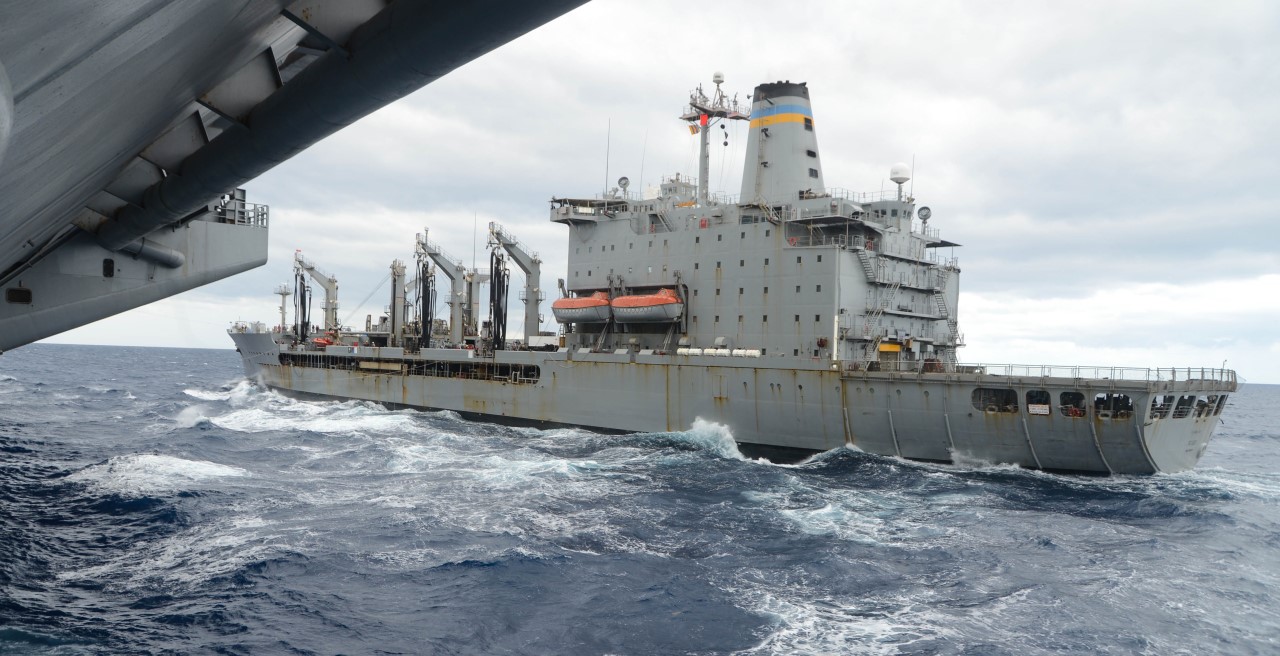
Oiler Patuxent comes alongside Harry S Truman
But while MSC's UNREP force is important and serves as a key capability multiplier for the USN, Military Sealift Command has many other responsibilities, ranging from its original job of hauling stuff around the world for the DoD to operating some of the most unique and unusual vessels in American service. We'll take a look at its other ships next time.
1 I don't have a detailed breakdown of exactly why this worked, but the short version is that a naval organization is based on high turnover and manning for peak requirements in combat. Civilian manning is based on longer service (fewer inexperienced people running around) and doesn't worry about combat. ⇑
2 Technically, only three ships with "A" hull codes remain commissioned by the USN. One of these is USS Pueblo, captured by North Korea in 1968. The other two are submarine tenders, and they are operated by joint USN/MSC crews. A similar arrangement is used on the flagship Mount Whitney and the floating forward bases. ⇑
3 The last three units of the class were modified while under construction to be double-hulled in line with tanker standards, and can only carry around 160,000 barrels. ⇑

Comments
I realize that high manning is important for damage control and combat, but damn, over 300 to 100 in the 70s with ships with no computers and automation? the USN needs to get a handle on its manning addiction. even if it's just building the ships for double manning in wartime and lean manning in peace, stuff like that just isn't affordable anymore.
What does "T-AKE" stand for? From context, it seems to have something to do with the Lewis and Clark dry cargo vessels, but I'm not sure what acronym means. Surprisingly, Wikipedia isn't helpful either, merely redirecting links to T-AKE to the page for the Lewis and Clark class.
It's their hull code. It comes from the combination of the cargo ship (AK) and ammunition ship (AE) symbols. It might be more accurate to use AFE (AF being stores ship) but it is what it is.
The draft was coming to an end, and the cost of manpower was rising rapidly.
Was the cost of manpower rising? Or was it that it now needed to be paid for in cash, which appears on the budget, rather than directly requisitioned from the population via draft?
The actual cost to the nation as a whole may have gone down (less disruption, less overmanning to deal with minimal training).
I'm looking at it strictly from the Navy's perspective, and by that metric, it was rising. You're probably right about it from the nation's perspective as a whole, but that's rather outside the scope of this post.
Interestingly, the Lewis and Clark class has Nulka and SRBOC launchers, which the preceding Sirius/Lyness and Mars classes did not have. I have no idea if these are usually loaded, or if it's one of those "well, we'll embark a CTT det if we think you're going to need them" items, but it's an interesting note. AFAIK, there's no such gear on the Kaisers - at least, there wasn't the last time I was close to one, which was 2011.
How does vessel defense for government-run civilian ships work? Are they allowed small arms? Not-so-small arms?
I know more about the British RFA than about MSC. In the RFA case, the vessels are often armed with some combination of Phalanx CIWS, 20mm and 30mm cannon, and machine guns. I believe that the ships' civilian crews are trained to operate these (with the possible exception of Phalanx).
The UK also has what may be some of the world's last true armed merchantmen, the three nuclear fuel transport ships of Pacific Nuclear Transport Limited. In that case, the ships carry civilian police officers (from the UK Civil Nuclear Constabulary) to operate their 30mm cannon.
@Jade
That's interesting. I can think of a bunch of reasons it might be the case, but none have enough evidence to be worth reporting. We'll have to see what the John Lewis class has before we know more.
@Garrett
I believe it's just deployments of security detachments when there's a threat, with small arms. MSC is a bit less military than the RFA. In wartime, they're fitted to get things like Phalanx, and that would come with a Navy team to run them.
To add on to the discussion about armament on MSC ships, as bean mentions, they rely on the USN to provide small detachments of sailors to carry small arms and man crew-served weapons. It's not hard to slap Mk 38s (25mm autocannons), especially the Mod 1s that are manually trained. The older ones are FNW (fitted For, Not With-eg space is reserved for these to be installed later) CIWS mounts, and I'd be surprised if at some point in the Lewis and Clark class that was upgraded to SeaRAM (or either/or) mounts. Some of the REALLY old ones (Like the Supply-class fast combat support ships) had Sea Sparrow launchers mounted from when they were part of the active CLF, probably could be put back on. I imagine those are about the limits of what you could do, though.
@cassander:
To be fair, it wasn’t affordable then, either. That’s why they did the experiment with Taluga.
It should be noted that there were a few drivers of large crew manning on ships of the WW2 era:
1.Secondary armament, especially AA guns (go look at all the pictures of Bofors 40mms firing and note the gaggles of dudes passing clips around)
2.Steam turbines, which were designed to be pretty maintenance and manpower intensive, and operated even more so
3.Preservation, which was intended to be done mostly by a deck force of low-skill guys
4.Related to the last, a manning model that relied on large numbers of guys with low training “apprenticing” for lack of a better term, but poor retention for those guys. M
MSC fixed secondary AA crew manning requirements by getting rid of guns, and really fixed the manning model by emphasizing guys with much better training at the start (theoretically, a qualified MSC guy should be able to walk in off the street, take a few hours to read a few ship’s specific instructions, and be able to take the watch and start operating. This does not work in the uniformed Navy.
I hate markup, mods, please delete that post